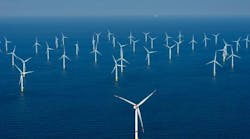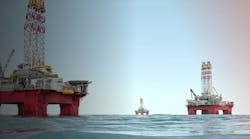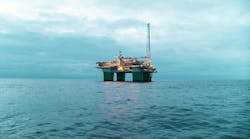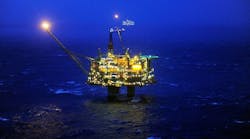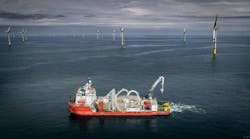National energy demands, desire to export, maturing plays driving frontier exploration
Dev George
Managing Editor -- International
What drove the predecessor of Elf Aquitaine to delve deep into the swamps of French Equatorial Africa. What was it that forced Arco and Standard Oil to brave the winds and sub-zero cold of Prudhoe Bay. What compelled Woodside to withstand the heat, cyclones, and sharks of Australia's Northwest Shelf. Whatever it was that made these and so many others seek oil in some of the wildest, most inhospitable frontier regions of the world is still out there, taunting explorers to drill a few holes, to shoot some seismic, to try to find just one more elephant in an area few have searched before.
Frontier exploration offshore has never been as frenetic as it is these days. Almost anywhere in the world where there isn't a moratorium, a ban for one reason or another, or a pristine environment protected by law or convention, there are probably exploratory probes drilling for hydrocarbons or at least acquiring seismic data, despite the high cost and the inherent risks.
These days most major and independent operators prefer to play it safe in proven provinces or allocate only a small segment of their exploration budgets to frontier activities - often only after someone else has established the presence of hydrocarbons in the area. But more and more, the pressures to find new sources of oil and gas are compelling operators to take a chance on a new prospect. Aside from the allure of discovering a new hydrocarbon play in a previously undrilled area, this renewed attraction to frontier exploration is being precipitated by the maturation of the traditional petroleum producing areas of the world, by the economic growth and industrialization of numerous Third World countries and the consequent demand for new petroleum sources, and by national desires for energy independence and/or means of earning sorely needed foreign exchange.
Oil is where you find it
Frontier zones are in what are generally considered remote regions of the earth, far from most markets and established infrastructure, and in harsh climates or difficult-to-work-in environments, including water depths in excess of 200 meters. They are areas in which little, if any, drilling has occurred, perhaps even where seismic acquisition has been sparse or not at all.
Some may describe frontier zones as simply regions of high risk, for one reason or another, but usually geological or political, while still others maintain that any area is a frontier if it doesn't have active major oil companies. For the purposes of this review, however, we are limiting the list to geographically remote areas where little drilling has been done.
The Arctic
For more than 30 years, there has been some seismic acquisition and a bit of exploratory drilling in the arctic regions of both Europe and America, and considerable hydrocarbons have been encountered, but the region remains a frontier because the cost of drilling, development, and delivering the oil to market far exceeds the potential return at today's price of oil.
Despite its desire to capitalize on its known arctic offshore reserves, Russia has done little exploration and even less to let others participate in bringing these reserves onstream. From the Barents Sea east to the Kara, Laptev, East Siberian, and Chukchi, some feasibility studies and proposed projects have been done, but little else, even though all are proported to be highly prospective The Barents Sea, in particular, has such known structures as the Schtock-manovskoye, Arkticheskaya, and Dudlovskoya Fields, and neighboring Kara Sea has the Rusanovskaya, Leningradskaya, and Zapadno-Sharapovskaya Fields, which together could easily become one of the world's leading petroleum provinces in the 21st century. Today, however, they embroiled in bureaucratic one-upmanship and go essentially unexplored and undeveloped.
Last year, the US and Russia signed a memorandum of understanding for the simultaneous exploration and development of their Chukchi Sea aquatories in the Arctic Ocean northwest of Alaska. Blocks are to be leased next year following joint efforts at assessing the region's prospectivity.
The Alaskan Beaufort Sea may attract more interest now that oil exports are once more allowed. BP is maintaining its presence, now drilling delineation wells on its Badami Field from an artificial ice island off the eastern North Slope. The field is said to hold 100 million bbl oil. A pipeline is to carry production to shore.
Greenland may fair better than most in finding explorers for its frontier region in the Baffin Bay, Davis Strait area off its west coast. A small Canadian company, gr nArctic Energy, has been doing extensive exploration in the Nuussuaq Peninsula area, including seismic both nearshore in the fjords and bays, and on the shelf. Geological indications are that a number of important trends traverse the area, but no other exploration has been done to date.
Europe
With the traditional North Sea fields maturing rapidly, the UK is putting considerable emphasis on its West of Shetlands aquatory, which has garnered early successes, even though there is a total lack of infrastructure and huge sea swells sweep the area. Said to hold approximately 5 billion bbl oil and little gas, the frontier region is predicted to become the UK's next major province. Accordingly, some 40% of the UK's 16th licensing round lies in the area, and several significant discoveries have already occurred there, particularly BP and Amerada Hess's Foinaven and Schiehallion Fields, where production is set to begin this year to an FPS, and Amerada's Strathmore and Solan. The 17th round is pushing even farther west, and will front the Faeroe Islands' aquatory.
The Faeroe Islands, a department of Denmark, are a virtually unexplored frontier that is attracting some attention as the North Sea operators scout for new venues. A remote, deepwater region with a harsh environment, it has seen little exploration save a few exploratory wells and a 12,000 line km seismic survey done last year over most of the prospective Faroese waters by Western Geophysical. Mobil, however, is soon to do another survey in these waters.
The Faeroese need the revenue petroleum production would earn, but they have little to finance exploration. A border dispute with the UK also complicates matters, but it is expected to be settled in time for the first licensing, expected next year. A BP discovery near the Faeroe frontier has sparking interest in the area, and a consortium of Enterprise Oil, Mobil, and Denmark's Statoil is preparing to enter the area.
South of the Faeroes, the Atlantic north and west of the Hebrides, is virginal aquatory and attracting some attention as the prospectivity of the West of Shetlands region continues to advance. New seismic has been shot and several key tranches are being studied to add to 17th Round licensing information. Digicon has done 2D, and a 3D aeromagnetic survey was done by World Geoscience. Prospecting, it is said, look very good.
Ireland has entered the frontiers competition with its Slyne, Erris, and Rockall Troughs and, farther southwest, its Porcupine Basin. The Troughs were the first Irish offering in the country's western offshore region, and Porcupine was its second. Both lie in deepwater zones ranging from 300 to 2000 meters depth. Little is known of their geology, although one Porcupine field, Connemara, with estimated 200 million bbl oil, is known but considered uncommercial. Aran, Monument, Texaco, Repsol, Statoil, Murphy, Santa Fe, and Enterprise hold leases and are just beginning to explore with tentative drillings and seismic.
Caribbean/Atlantic
Although there has been a reasonable amount of seismic shot and sporadic exploratory drilling done on the Jamaican Plateau off Nicaragua, no commercial levels of hydrocarbons have been found so far. This is not to say they aren't there. Seismic indications are that the Plateau may harbor several highly prospective structures, mostly off the northwest coast of Nicaragua.
Another mystery frontier yet to be verified is the aquatory around the UK-administered South Georgia Islands, in the South Atlantic. Claimed by Argentina as a part of its Atlantic province, it lies east-southeast of the Falkland/Malvinas Islands on a trend with the Sandwich Islands. The shelf is wide and shows promise, but drops rapidly to depths of over 4,000 ft. To date, no commercial levels of hydrocarbons have been found, although limited seismic and aeromagnetic indicate their presence.
Africa
There are numerous frontier provinces around the littoral of Africa, but most have witnessed very little exploratory ventures other than an occasional 2D seismic survey and even less frequent drilling of wells. Oil is there, however, and in massive quantities, particularly in the most active petroleum province, West Africa, which includes some of the world's major producing regions and considerable development.
Although they are by their very nature frontier ventures, the current exploration and development of the deepwater aquatories of Nigeria, Gabon, Angola, Congo, and Namibia are excluded from this survey. Elsewhere in West Africa, however, almost every other country is carving up its aquatory and offering often attractive terms to any operator willing to risk exploring off the established track.
Tiny Gambia, for example, wedged into Senegal, is attempting to attract attention to its offshore petroleum possibilities. Now that 3D seismic technology is able to penetrate the salt structures, the prospects look good. An offering is at hand. Nearby, Liberia is also offering its full aquatory to all comers, hoping the trend offshore neighboring Cote d'Ivoire continues into its own aquatory. Guinea, too, for the first time is hawking its petroleum prospectivity, but of all these marginal West African countries, it is only in Senegal, where some seismic and exploratory drilling has occurred, that the prospects look brightest, again, brought about by the advent of salt-penetrating 3D seismic and new drilling techniques. Several majors are there, so far without commercial success.
There has been little interest in the other side of Africa, other than occasional 2D seismic shoots and a few unsuccessful exploratory wells over the years, but Mozambique, Tanzania, and Kenya are now vying for frontier explorers of their respective aquatories. Mozambique has seen more exploration of its shelf and slope area than the others. Beginning in the early 1980s, there has been interest in the shallow water area, with CGG, Geco, Western, and Horizon each making major 2D seismic studies. Several wildcats were drilled, by BP and others, but no commercial reservoirs have been found to date. Gas appears to predominate, but several thick structures have been interpreted as possible oil.
In the Indian Ocean 400 km off the east coast of Africa, Madagascar and the Seychelle Islands are both frontiers in hopes of exploration and discovery. Madagascar, in fact, is the site of two giant onshore heavy oil fields, Bemolanga and Tsimiroro, but, despite wildcats on its shelf by Agip in the Majunga Basin, and seismic by Conoco, Chevron, Tenneco, and Amoco, no further drilling has occurred. The Seychelles, on the other hand, are now garnering considerable attention due to Enterprise Oil's current exploratory program there. The independent plans a drilling program to begin later this year with a wildcat some 200 km southeast of the main island of Mahe on the Constant Bank. This as a result of the company having acquired almost 6,000 km of seismic/gravity/magnetics data recently.
Asia-Pacific:
Even though there are many long established, oil and gas plays throughout the Asia-Pacific region, several other remote or difficult locations are opening up as frontier zones and attracting both major and minor explorers and producers.
Foremost among these are the isolated prospects off Indonesia's eastern islands. From the southeastern shores of Kalimantan's Makassar Straits to the Molucca and Ceram Seas between Sulawesi and Irian Barat, the Arafura Sea and Timur Gap, Indonesia is promoting prospects to foreign operators either in joint venture with Pertamina or alone, sweetening the deal to compensate for the lack of infrastructure and the often deep water of the area.
Total, Unocal, Phillips, BHP, Arco, and others have begun exploratory seismic and drilling, and most are finding good indications of hydrocarbons. Arco, in fact has hit upon a 100 cf/d gasfield in Irian Jaya, one of Indonesia's most remote provinces, the Berau Field.
Taking Indonesia's lead, Malaysia is also offering tempting terms to operators who will explore and develop its remote, deepwater (200 meters or more depth) prospects off Sabah and Sarawak. Mobil was the first to be awarded tracts here, Blocks SK-A, SK-B, SK-C, and SK-D, ranging in depth from 1,000 to 1,800 meters, has been acquiring seismic over the blocks, and has spudded one well, Mulu-1, in 1,185 meters of water in Block SK-A. Shell, in a PS contract with Petronas, was granted the first deepwater tract off Sabah, Block G.
The archetype of frontier itself, is Papua New Guinea's Gulf of Papua. Although considerable drilling and development have been done onshore Papua New Guinea, little exploration or development has been seen in the Gulf. The one field that has precipitated outside interest is Pandora, discovered by IPC in PPL82 in 1988. Since, it has been proven with stepouts, delivering a gas flowrate of 43 million cf/d, and has been taken over by Mobil. Over the last year, Mobil has been acquiring some 2,000 km of 2D and 12,000 sq km of 3D seismic data via Geco Prakla's vessel Resolution over this and PPL152. Two new wells were drilled at the end of 1994.
For political and economic reasons, in addition to its remoteness and the hostility of its Okhotsk Sea aquatory, Sakhalin Island qualifies as the epitome of a petroleum industry frontier. Despite years of negotiation and agreements, contracts and decrees, nothing has come of any of the much touted projects to explore and develop the considerable reserves of the region.
North Korean offshore exploration is being kicked off by new concessions in the East Korea Bay granted to Australia's Claremont Petroleum and its affiliate Beach Petroleum. The only other North Korean concession is held by Sweden's Taurus Exploration. Very limited exploration has occurred in the area, mostly by Russians, who shot about 3,500 km of seismic and drilled at least four wells.
Other Asian frontiers garnering attention are India's Andaman Islands, which have been put on offer in the last licensing round, as well as the Palk Strait between India and Sri Lanka. The Philippines is promoting its Sulu Sea region, where new seismic has being acquired with leasing in mind. And China is putting considerable effort into its East China Sea, which has been extensively leased.
In the South Pacific, Fiji has drawn considerable attention with its offering of concessions in three licensing blocks: A, in the Bligh Bight between Viti Levu and Vanua Levu, the main islands, D, south of Vanua Levu, and C, in the southern Lau Island Group east of the Koro Sea. Likewise, Vanuatu's oil reserves, indicated by both seismic and AGSO geological evaluations, may be of a commercial level. A licensing is likely later this year. The petroleum potential, which has been compared to that of Southeast Asia, is said to be indicated around the island of Santo and Malekula.
South America:
Finally, the frontiers of South America lie mainly onshore, but two offshore provinces have drawn sizable outside interest, Brazil's NE coast, and the Malvinas/Falklands off Argentina. Both are beyond the present petroleum infrastructure of the countries, but are being explored for the large reservoirs of oil each is anticipated to hold. Petrobras is just beginning to explore its northeast coast, having conducted major seismic studies of the area over the past few years. In particular, it believes major reserves are to be found on the Brazilian shelf from Baia de Sao Marcos southeast to the easternmost point of the country at Rio Grande do Norte. Exploratory wells were drilled last year, and further exploratory drilling will be done in the second half of this year.
And then there are the Malvinas/Falklands, long ignored and now prized by both the UK and Argentina, since it is believed the shelf surrounding the islands and to their north contains large deposits of hydrocarbons. Seismic acquisition has been underway for more than a year, and it is thought the UK will be issuing licenses for exploration soon. There is, of course, one sticking problem: Argentina also claims the islands and has gone to war over them in the past. The two powers are talking, perhaps of ways of cooperating in the development of the islands' reserves, but it is mostly a moot question, since today's price of oil makes production there prohibitively costly for all but the Argentine market.
Copyright 1996 Offshore. All Rights Reserved.
